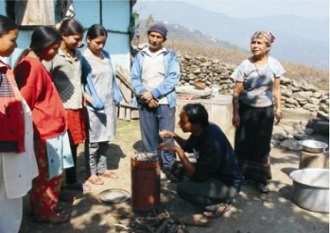EcoSecurities’ Lisa Ashford explains how a simple change to cooking stove designs can help to cut carbon and improve lives.
I want to bang the drum about energy-efficient cooking stoves.
The “technology shift” away from the standard three-stone stove to a more efficient model is slight, but the impact that can be made is significant.
Over 2.5 billion people worldwide cook using biomass. In developing countries up to 50 per cent of current energy needs come from cooking and the major mechanism for this is a simple three-stone cook stove that uses either fossil fuel or firewood. This fuel can often be expensive and, in some cases, unreliable in supply. In the case of firewood, there is also the threat of accelerating deforestation as the demand for fuel increases. Furthermore, the health effects of using the most basic cook stoves indoors are hugely negative due to exposure to toxic fumes and inadequate ventilation.
Switching to alternatives may seem like a relatively easy thing to do but, in practice, not only do you need to get over the cost hurdle of buying a (new) stove, but there are years of ingrained tradition involved in favoured cooking methods and some sense of scepticism over new technologies.
In fact, even though the new stove may save money in the long term with regards to the fuel, that isn’t always the “kicker” needed to get energy-efficiency projects off the ground.
The carbon market has a part to play here in helping to accelerate the roll out through capacity building, acting as investment support and a market primer, and making the stoves more affordable, whilst at the same time saving emissions. Some people criticise offsets for forcing poorer people in developing countries into making emission reductions whilst the West continues to churn through fossil fuels faster than you can say SUV. In fact, offsets enable this switch in technology that not only creates emission reductions, but has real and tangible benefits in terms of improving health and living conditions, allowing more money to be spent on other basic services and commodities like education and food.
Another argument is that these do not provide the scale that is necessary for them to make a real impact. I would certainly question that theory and have to quote the words of the Dali Lama: “If you think you are too small to make a difference, try sleeping with a mosquito.”
An early starting cookstove project in Cambodia recently announced that it has sold over one million stoves. Whilst these projects do start small (by their very nature), they have the ability to scale up after the first couple of years. The proof of the concept is more convincing as an increasing number of households start to use them. This dissemination is also largely bolstered by budding entrepreneurial networks that manufacture the new stoves and those which distribute and sell them.
Exchanges in skills have taken place between Asia and Africa in terms of the lessons taken on board and I am hopeful that carbon finance can continue to facilitate the expansion of this new technology into other geographies and markets. There are a number of cookstove projects in the development cycle from a carbon perspective, but the projects are complex and it is not a quick process to get them up and running either, both in terms of carbon (ie registering the projects) or of their on-the-ground-operation.




